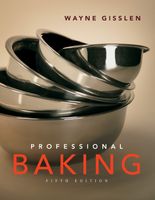Advertisement
Rangetop Puddings
Published 2008
- Cornstarch pudding or blancmange.
Cornstarch pudding consists of milk, sugar, and flavorings and is thickened with cornstarch (or, sometimes, another starch). If enough cornstarch is used, the hot mixture may be poured into molds, chilled, and unmolded for service. (The term blancmange, pronounced, approximately, blaw mawnj, comes from the French words for “white” and “eat.”) - Cream puddings.
Cream puddings , as we have suggested, are the same as pastry cream. Puddings are usually made with less starch, however, and may contain any of several flavoring ingredients, such as coconut or chocolate. The flavor of butterscotch pudding comes from using brown sugar instead of white sugar.If you look again at the formula for pastry cream, you will see that the only difference between cornstarch puddings and cream puddings is that the latter contain eggs. In fact, cream puddings may be made by stirring hot cornstarch pudding into beaten eggs and then heating the entire mixture to just below a simmer. Care must be taken to avoid curdling the eggs if this method is used.
Because these puddings are basically the same as pastry cream, which in turn is used for cream pie fillings, it is not necessary to give separate recipes here. To prepare any of the following puddings, simply prepare the corresponding cream pie filling, but use only half the starch. The following puddings can be made on this basis:
- Vanilla pudding.
- Coconut cream pudding.
- Banana cream pudding (purée the bananas and mix with the pudding).
- Chocolate pudding (two versions, using cocoa or melted chocolate).
- Butterscotch pudding.
- Puddings bound with gelatin. A pudding not thickened with starch or eggs must be bound or stabilized using another ingredient. Gelatin is often used for this purpose. One of the simplest and most popular desserts of this type is
panna cotta , which is Italian for “cooked cream.” In its most basic form, panna cotta is made by heating cream and milk with sugar, adding vanilla and gelatin, and chilling in molds until set. It is often served with fruits or caramel sauce.Mousses and Bavarian creams, which owe their light texture to whipped cream or meringue, are often bound with gelatin. They are covered in detail later in this chapter.

